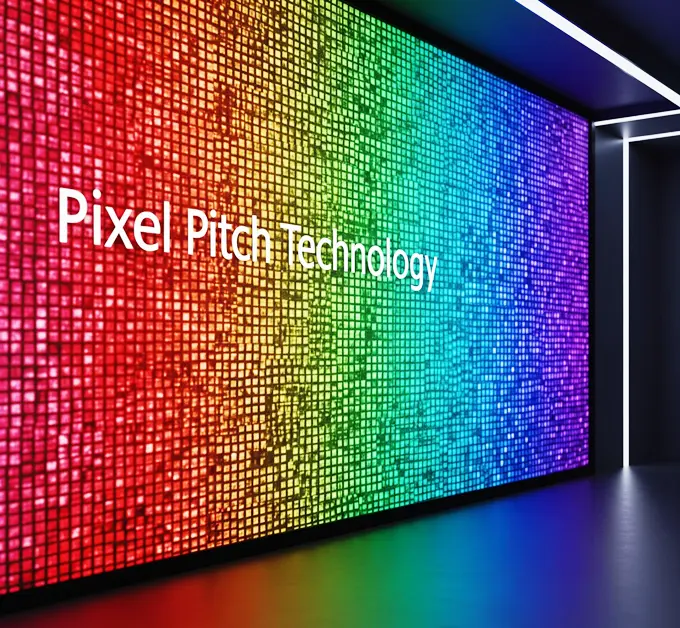Pixel Pitch Technology in LED: Mastering Density, Distance, and Clarity for Stunning Visuals
Published: 25 May 2025
Pixel Pitch Technology in LED: Mastering Density, Distance, and Clarity for Stunning Visuals
In the realm of LED displays, pixel pitch technology in led is the cornerstone of image quality, determining everything from sharpness to optimal viewing distances. Whether you’re designing a control room, digital billboard, or a home theater, understanding pixel density optimization, viewing distance calculations, and fine-pitch LED screens is critical. This 3000+ word guide dives deep into the science and strategy behind pixel pitch, empowering you to make informed decisions for flawless visual experiences.

What Is Pixel Pitch? The Foundation of LED Clarity 🔍
Defining Pixel Pitch
Pixel pitch (measured in millimeters) refers to the distance between the centers of two adjacent pixels on an LED screen. Smaller pixel pitch = tighter pixel spacing = higher resolution.
Why Pixel Pitch Matters 🌟
- Image Sharpness: Smaller pitch values deliver crisper details.
- Viewing Experience: Determines the ideal distance for content visibility.
- Cost Efficiency: Balancing resolution with budget constraints.
Pixel Density Optimization: Striking the Perfect Balance 🎯
Understanding Pixel Density
Pixel density (pixels per meter, PPM) is directly tied to pixel pitch:
Pixel Density (PPM)=1000Pixel Pitch (mm)Pixel Density (PPM)=Pixel Pitch (mm)1000
A smaller pitch (e.g., P1.2) yields higher density (833 PPM), while a larger pitch (e.g., P10) offers lower density (100 PPM).
Applications by Pixel Density 🏢
| Pixel Pitch | Density (PPM) | Best Use Cases |
| P0.9 – P1.5 | 1111 – 666 | Control rooms, luxury retail |
| P1.5 – P2.5 | 666 – 400 | Corporate lobbies, museums |
| P2.5 – P4 | 400 – 250 | Conference halls, live events |
| P4+ | <250 | Billboards, stadium screens |
Optimizing Density for Cost & Quality 💰
- High Density (Fine-Pitch): Ideal for close viewing but costly.
- Low Density: Budget-friendly for large, distant audiences.
Viewing Distance Calculations: Science Meets Practicality 📏
The 1:1 Rule of Thumb
A general guideline:
Optimal Viewing Distance (m)=Pixel Pitch (mm)×1Optimal Viewing Distance (m)=Pixel Pitch (mm)×1
For a P3 screen, the best viewing distance is ~3 meters.
Advanced Formulas for Precision 🔢
- Minimum Viewing Distance:
text{Distance (m)} = text{Pixel Pitch (mm)} times 0.3 ]
2. Maximum Viewing Distance:
Distance (m)=Pixel Pitch (mm)×8Distance (m)=Pixel Pitch (mm)×8
Case Study: Times Square Billboards 🗽
A P10 LED screen (10mm pitch) is optimized for viewers 10-80 meters away, ensuring readability from blocks away.
Fine-Pitch LED Screens:
Where Detail Meets Innovation 🌟
What Are Fine-Pitch LED Screens?
Fine-pitch LEDs have a pixel pitch of ≤P2.5, offering ultra-high resolution for close-range applications.
| Advantages of Fine-Pitch Technology |
|---|
|
| Challenges to Address ⚠️ |
|---|
|
Choosing the Right Pixel Pitch for Your Project ✅
Factors to Consider 🧩
- Audience Proximity: Closer viewers need finer pitches.
- Content Type: Text-heavy displays demand higher density.
- Budget: Balance resolution with ROI.
Industry-Specific Recommendations 🏭
- Retail: P1.2-P2.5 for product showcases.
- Control Rooms: P0.9-P1.8 for real-time data monitoring.
- Sports Arenas: P4-P6 for crowd-facing replays.
The Future of Pixel Pitch Technology 🔮
Micro LED Innovation 💡
Micro LEDs shrink pixel pitch below P0.7, enabling bezel-free, cinema-quality screens for homes and studios.
AI-Driven Optimization 🤖
Machine learning algorithms auto-adjust pixel density based on ambient light and viewer movement.
Flexible & Transparent LEDs 🌐
Foldable screens with ultra-fine pitches (P1.0) for curved retail displays or AR integration.
FAQs About Pixel Pitch Technology ❓
1. Does smaller pixel pitch always mean better quality?
Yes, but only if viewers are close enough to perceive the detail. For distant audiences, larger pitches are more cost-effective.
2. How does pixel pitch affect screen brightness?
Smaller pitches often have lower brightness (nits) to prevent eye strain in indoor settings. Outdoor screens prioritize brightness over density.
3. Can I retrofit an older LED screen with a finer pitch?
No-pixel pitch is determined during manufacturing. Upgrading requires replacing panels.
4. What’s the lifespan of fine-pitch LED screens?
Typically 60,000–100,000 hours, but dense pixels may degrade faster due to heat.
5. Are fine-pitch LEDs suitable for outdoor use?
Yes, with IP65+ ratings for weather resistance, but they’re costlier than standard outdoor pitches.
Conclusion: Pixel Precision for Unmatched Visual Experiences 🎯
Pixel pitch technology is the unsung hero of LED displays, dictating clarity, engagement, and ROI. By mastering pixel density optimization, viewing distance calculations, and fine-pitch LED screens, you can tailor displays to mesmerize audiences—whether they’re inches or miles away. As advancements like Micro LED and AI redefine possibilities, the future of visual storytelling has never been brighter.

- Be Respectful
- Stay Relevant
- Stay Positive
- True Feedback
- Encourage Discussion
- Avoid Spamming
- No Fake News
- Don't Copy-Paste
- No Personal Attacks



- Be Respectful
- Stay Relevant
- Stay Positive
- True Feedback
- Encourage Discussion
- Avoid Spamming
- No Fake News
- Don't Copy-Paste
- No Personal Attacks





